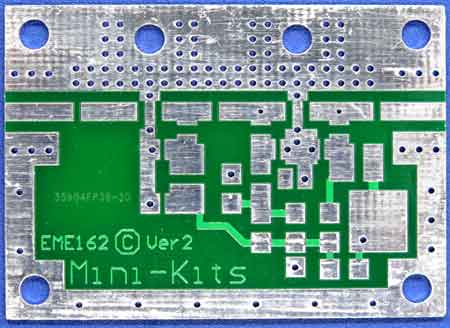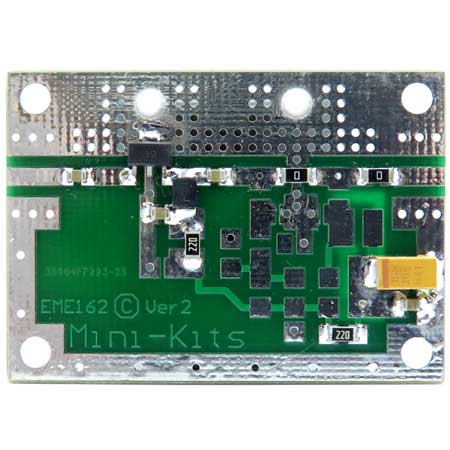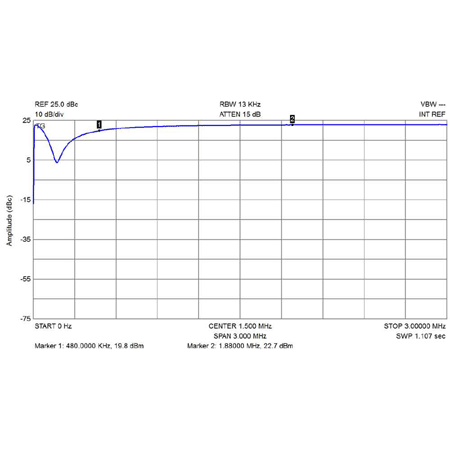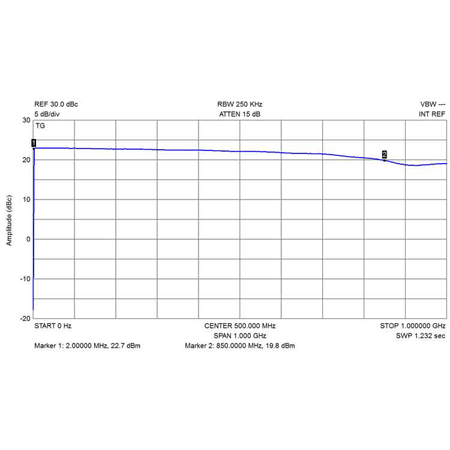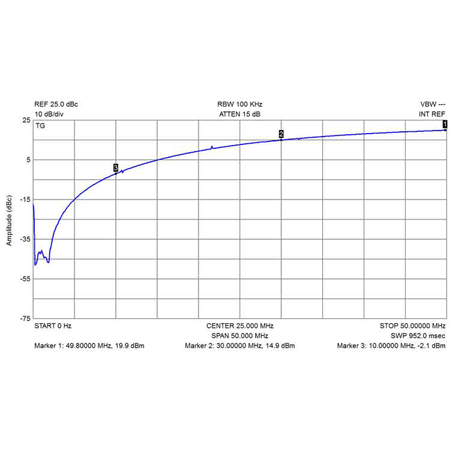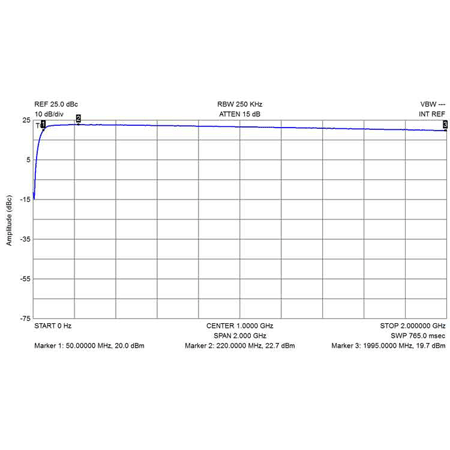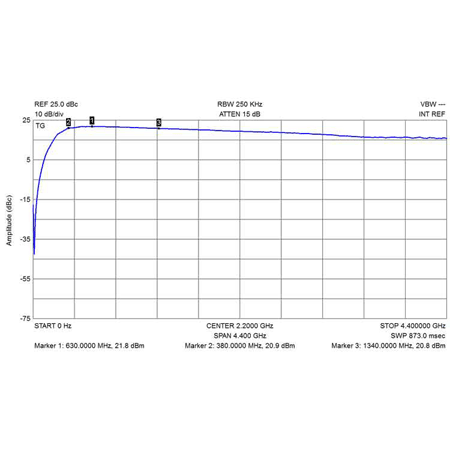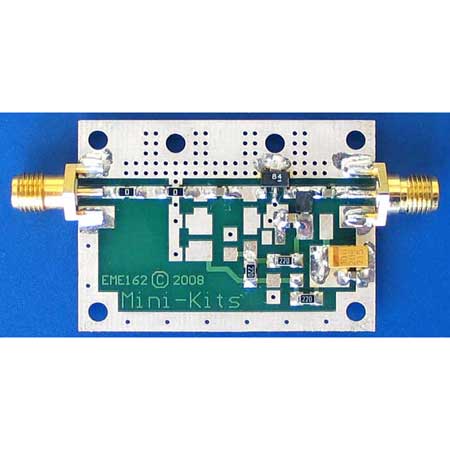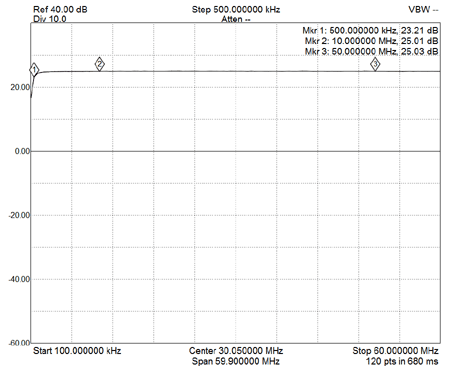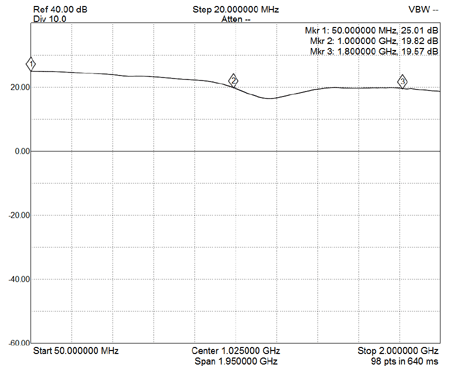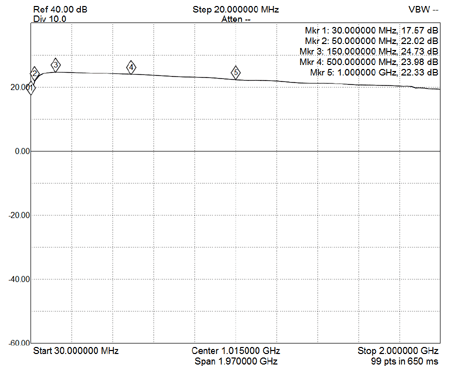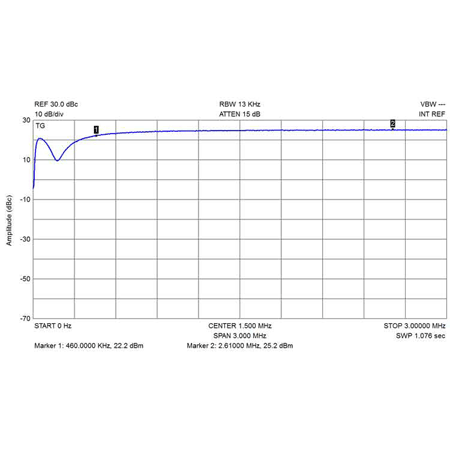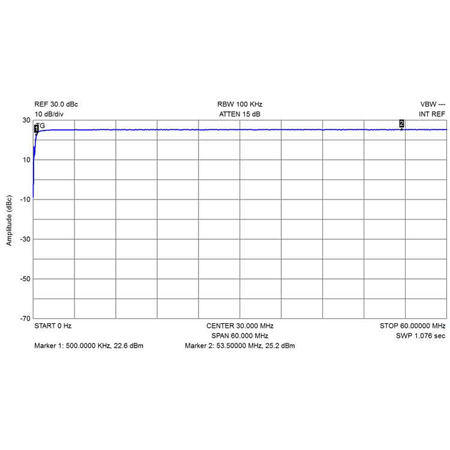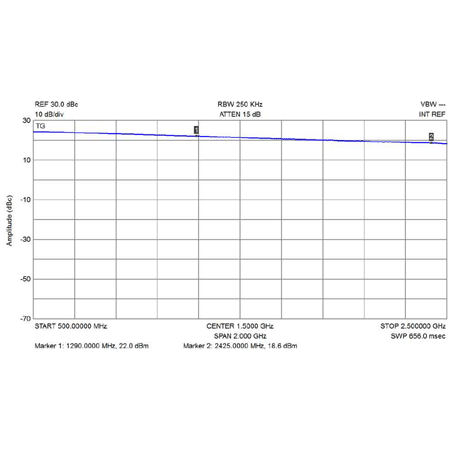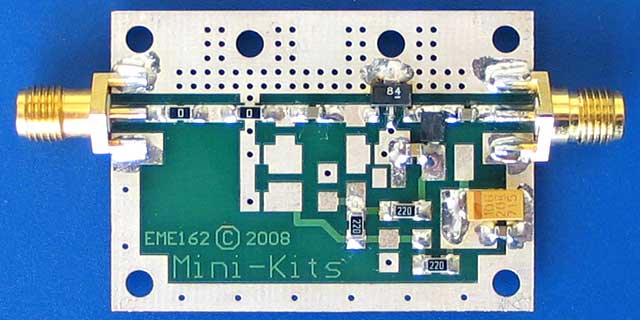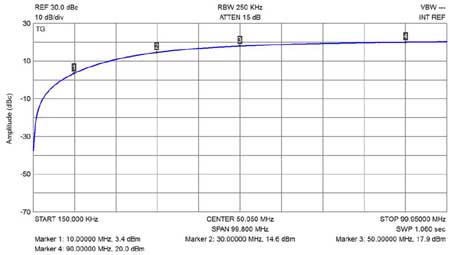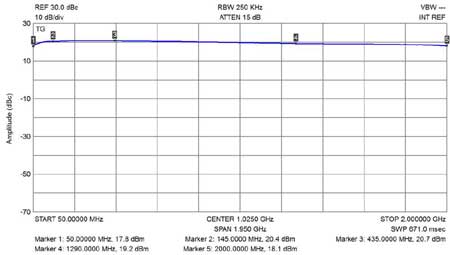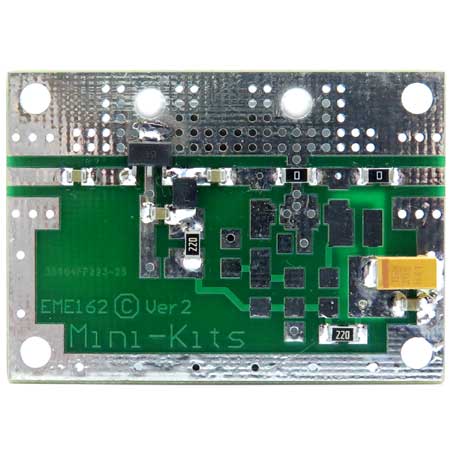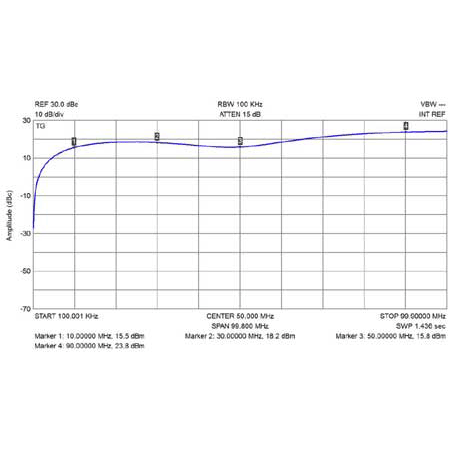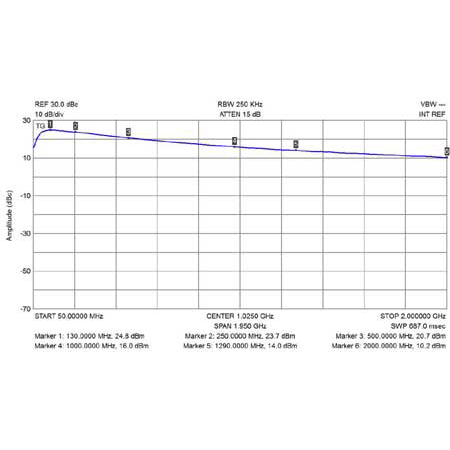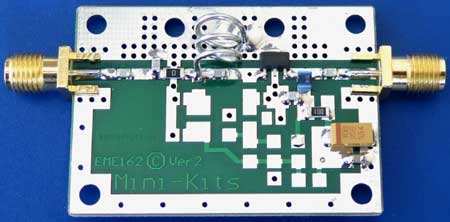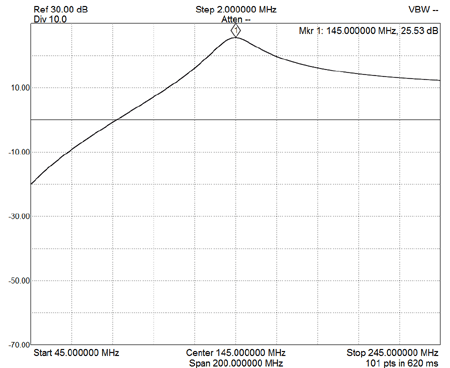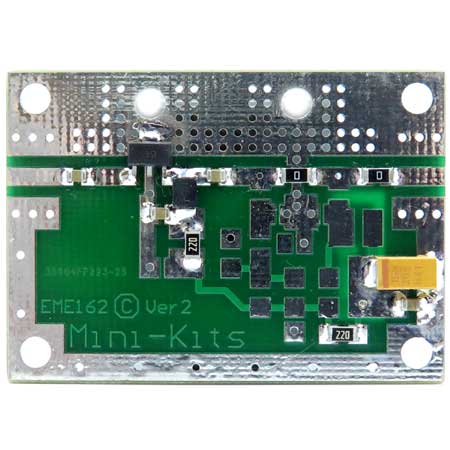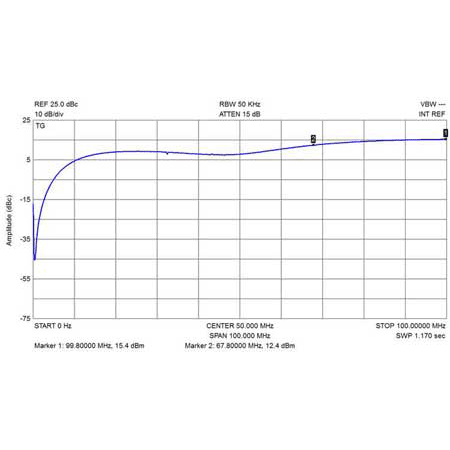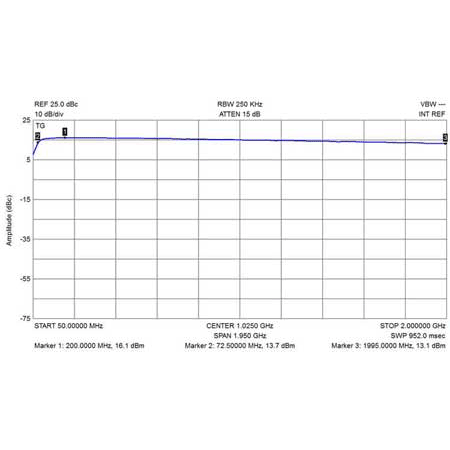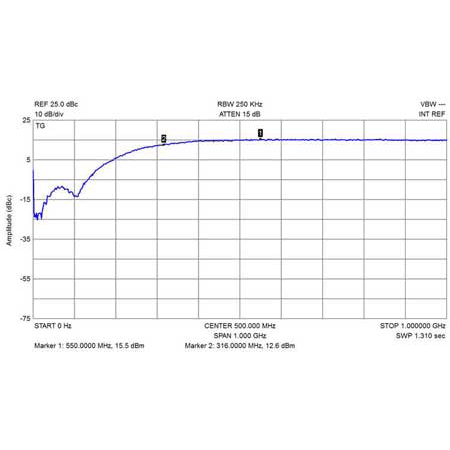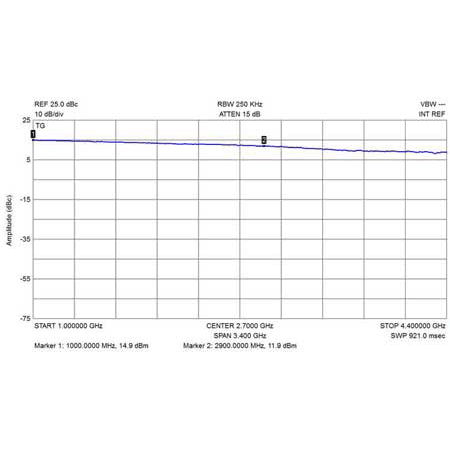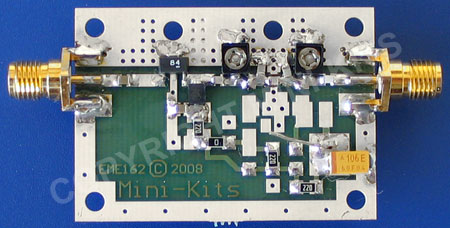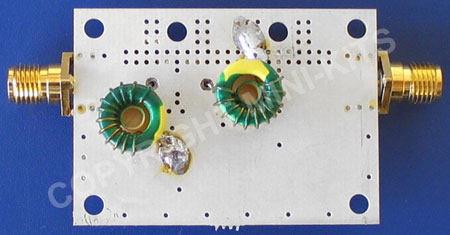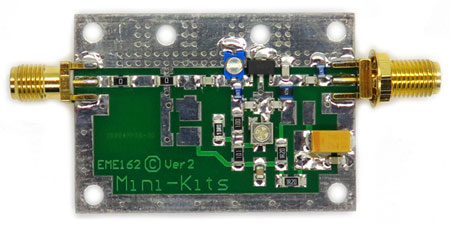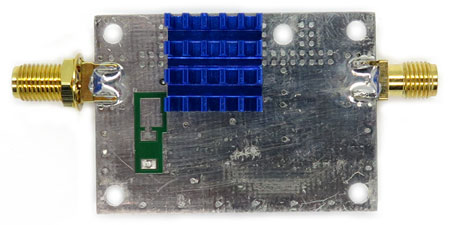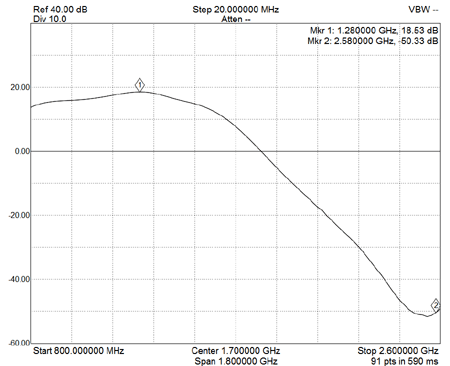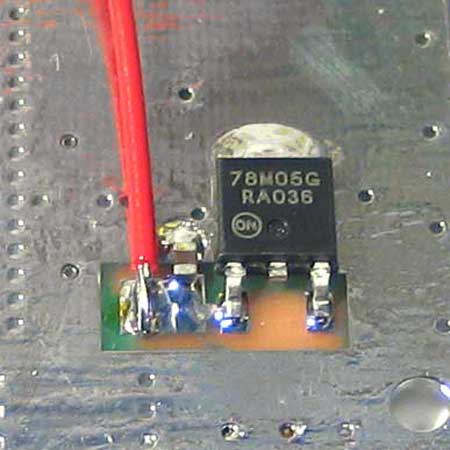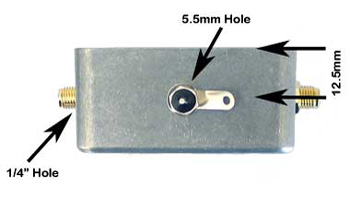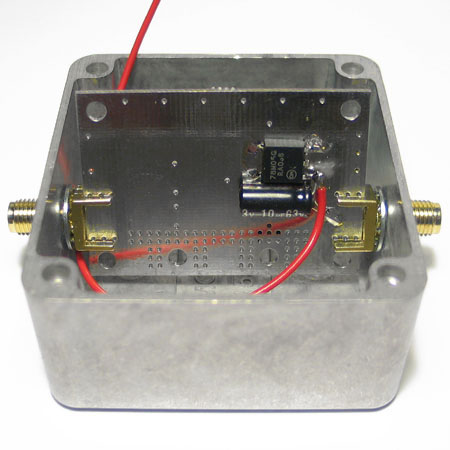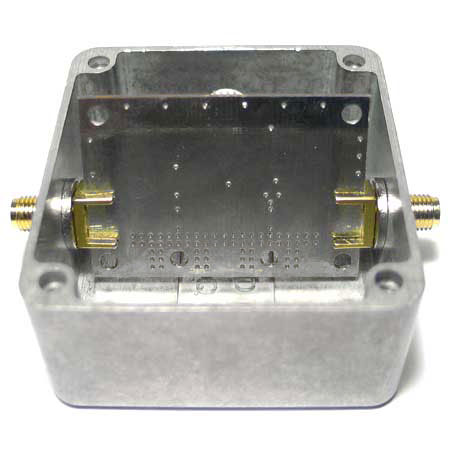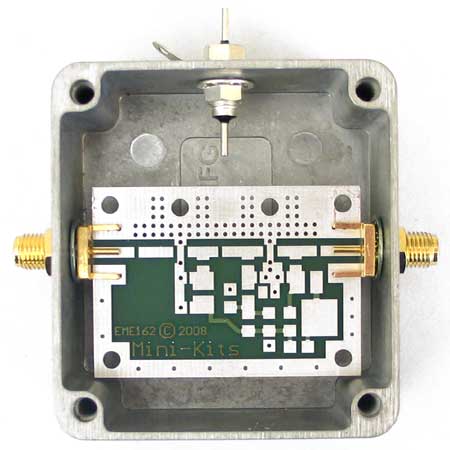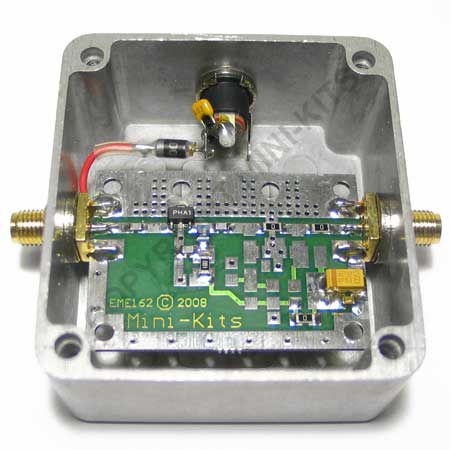EME162 Series Kits
- EME162 PC board Description:
Updated! Jan2024 - Kit Constructors Alert:
Updated June 2022 - GALI-39 Amplifier Kit:
- GALI-74 Amplifier Kit:
- GALI-84 Amplifier Kit:
- MGA-31189 Amplifier Kit:
- PGA-103 Amplifier Kit:
- PGA-103 2M Band RX Preamp:
Discontinued! - PHA-1 Amplifier Kit:
- 30MHz Multiplier Kit:
Discontinued Feb 2023! - EME162-1200-R2 Kit:
Updated! June 2020! - Mounting Into A Die cast Enclosure:
Updated! Aug 2016 - Kit Changes and Updates:
Updated! July 2015 - Buy A EME162 Series Kit:
The EME162 PC board was updated February 2014 to include mounting pads for a SMD voltage regulator on the bottom of the PC board. The EME162 PC board was designed to construct amplifier gain blocks for various applications using the Mini-Circuits MAR, ERA, and Gali MMIC amplifiers. Is it also suitable for most other x pack and SOT-89 packages that have the same lead pin outs. A simple 10 to 30MHz multiplier Kit was also developed in mid 2010 to suit the locking of Icom IC910 transceivers to either a GPS or Rubidium reference.
One of the most popular Kits was the EME162-1200 0.5 Watt 1200MHz amplifier Kit using the Avago ATF50189 PHEMT, that can be used as a driver amplifier for the 23cm band. This Kit is no longer available due to the ATF50189 being obsolete.
Mini-Kits stock a number of Wide band Amplifier Kits using the Mini-Circuits amplifiers which can be used as receiver or transmitter driver stages for various projects. There is little difference with gain between many of the devices, with some having a lower noise figure or can produce more output power @ 1dB compression. The GALI-39 KIT, PGA-103 KIT and PHA-1 KIT are suitable as wide band Pre-amplifiers for use with scanning and communications receivers, while the GALI-74 KIT, GALI-84 KIT, MGA31189 KIT, and PHA-1 KIT make very good low distortion transmitter driver stages.
The GALI-39 device is ideal as low level receiver or transmitter gain block amplifier from 500kHz to at least 7GHz. This Kit is supplied with components to suit 3 frequency ranges from 500kHz to 4GHz to get the maximum gain from the device. A 78M05 voltage regulator mounted under the board allows operation between +7 to +15vdc. BUY THIS PRODUCT
The built version of this product has been replaced with the Mini-Kits GALI39-R2
The GALI-74 device is ideal as low level receiver or transmitter gain block amplifier from 500kHz to at least 2GHz. This Kit is supplied with components to suit 2 frequency ranges from 500kHz to 2GHz to get the maximum gain from the device. A 78M08 voltage regulator mounted under the board allows operation between +9 to +15vdc. Built versions can be ordered to suit 2 different frequency ranges, and the GALI-74 mounted to suit either a receive or transmit applications. BUY THIS PRODUCT
The GALI-84 amplifier is particularly suitable as a transmitter gain block due to the high gain requiring only around -5dBm to produce over +20dBm output. When the input is driven to produce +10dBm output, the amplifier produces very low harmonic output. This amplifier is also suitable as a post mixer amplifier for transmitters and receivers, or a frequency multiplier. This Kit is supplied with components to suit 3 frequency ranges from 100kHz to 4GHz to get the maximum gain from the device. A 78M08 voltage regulator mounted under the board allows operation between +9 to +15vdc. BUY THIS PRODUCT
The built version of this product has been replaced with the Mini-Kits GALI84-R2
The MGA-31189 amplifier is ideal as high gain 0.25W driver amplifier, or a low noise high dynamic range amplifier for use between 50MHz and 2GHz. The amplifier has quite a flat gain response from 100MHz to 1300MHz. As a driver amplifier the MGA31189 produces an output between +23 to +24dBm @ 1dB compression from 100MHz to at least 2GHz. A 78M05 voltage regulator mounted under the board allows operation between +7 to +15vdc. BUY THIS PRODUCT
The built version of this product has been replaced with the Mini-Kits MGA31189-R2
The PGA-103 amplifier is ideal as a very low noise high dynamic range amplifier for use between 100MHz and 1.3GHz. It has however a very steep roll off of gain between this frequency range mainly due to the PGA-103 characteristics. As a driver amplifier the PGA-103 produces an output between +20 to +23dBm @ 1dB compression over this frequency range. A 78M05 voltage regulator mounted under the board allows operation between +7 to +15vdc. BUY THIS PRODUCT
The built version of this product has been replaced with the PGA103-WB-R2
The PGA-103 amplifier is ideal as a very low noise high dynamic range amplifier for use between 100MHz and 1.3GHz. The amplifier can be modified to cover a narrow band giving some rejection by adding a T type input filter to the input of the EME162 board. The application below is an Ultra Low noise 2M band 144-148MHz Preamplifier that has a measured 0.55dB noise figure and 24dB gain @ 144MHz. A 78M05 voltage regulator mounted under the board allows operation between +7 to +15vdc.
This built version of this product has been replaced with the PGA103-2M-R2 Amplifier.
The PHA-1 amplifier is particularly useful as an amplifier for complex RF waveforms, or as a low noise high dynamic range gain block in a receiver. The amplifier is supplied with components to suit a frequency range of 90MHz to 1GHz, and 400MHz to 1.6GHz. The lowest frequency is limited to around 200MHz due to the internal 50ohm matching, and produces up to +22.5dBm output at 1GHz. A 78M05 voltage regulator mounted under the board allows operation between +7 to +15vdc. BUY THIS PRODUCT
The built version of this product has been replaced with the Mini-Kits PHA-1-R2
10 to 30MHz x3 Multiplier for GPS locking the Icom IC910 and 9100
Transceivers to a 10.066667MHz GPS or rubidium reference. The Kit
uses the GALIi-84 Amplifier Kit and a two section 30MHz band pass
filter to produce a very clean and filtered output suitable for
locking the Transceiver. Typical output is +5dBm and may require
some attenuation to interface with the oscillator circuitry. A 78M08
voltage regulator mounted under the board allows operation between
+9 to +15vdc. The pictures below show an earlier version that does
not have the on board 8v regulator.
This Product has been confirmed many times as being a successful
modification on the IC910.
Tests on the Multiplier showed +9dBm output at 30.2MHz with +10dBm input on 10MHz. Harmonics are -50dBc which is excellent due to the coupled 30MHz band pass filter. A FE-5680A with +7dBm output, produced around +7dBm output at 30MHz. It is expected that only around +5dBm output may be required to lock the ICOM IC910. Mini-Kits has not tested this on an Icom IC910, so it will be up to the constructor to work out how to adapt it to work. We are unable to supply any fitting instructions, or how to program either a Rubidium, or a GPS locked source for the required 10.066667MHz output.
Thanks to Rob VK2GOM for helping with the comments below.
I must admit, I ended up buying two Rubidium's on Ebay before I found one that could be programmed. I have found that those Rubidium units that require a +5vdc input on the DB9 in order to enable the output are not programmable. Those that need only +13.8vdc (spec +15vdc) and ground to get an output are programmable.
The multiplier output is fed into connector pin2 on the PLL board where the CR-293 option would fit. A simple Pi attenuator was used to reduce the multiplier output to around 400mV +5dBm so that it allows the radio PLL to lock. It is not recommended that the trim pot R570 be adjusted as it would affect the radio when not using the Rubidium.
I have fitted a toggle switch on the rear of the Radio that turns off the +5vdc to the TCXO oscillator, ( CR-452 ) on the PLL unit PCB when using the Rubidium, as it was the easiest way to disconnect the TCXO.
The amplifier uses an Avago ATF50189 PHEMT which provides a gain of
over 18dB, and an output power of +27dBm ( 500mW ) @ 1dB
compression. The PHEMT requires minimal input and output matching to
50 ohms, and is particularly suitable as a driver amplifier for the
Mitsubishi RA18H1213G module when used for modes including FM,. SSB
and digital. The product requires a regulated +5vdc 500mA power
supply for operation. This Product is no longer available due to the
ATF50189 being obsolete. Please email Mini-Kits if you need a spare
part replacement.
Please Note: that the output power has been amended as recent tests
on this amplifier have shown lower output power compared to the
prototypes back in 2008. Original prototypes produced up to +29.5dBm
@ 1dB compression which has not been able to be reproduced with
tests made after December 2014. This could be due to manufacturing
changes to the ATF50189, another component, or possibly the PC board
material. This amplifier will however consistently produce over
+27dBm @ 1dB compression.
There can be some variations with connectors, and mounting hardware thicknesses that may require some experimentation when mounting boards into enclosures. Recently some SMA panel mount connectors may require additional washers due to the female thread not going all the way to the mounting flange. Many of the shake proof washers that are being supplied with SMA connectors are very flimsy and easily deform when tightening, so the use of a M6 shake proof washer can be used to securely hold the SMA connector to the enclosure.
-
Carefully mark the holes that have to be drilled into the Hammond 1550Q enclosure. Drill the 2x SMA39 connector holes to 1/4 inch, 6.35mm, and drill a 8mm hole to suit a 2.1mm DC socket.
-
Fit the 2x SMA39 connector using the 2x M6 flat or shake proof washers as shown in the picture above. The washers are used as shims to space the SMA39 connectors to suit the length of the PC board. Lightly tighten the buts still allowing the connectors to be able to be rotated. This can then place too much strain on the board damaging it by twisting.
-
Cut the SMA centre pins to a length of 3mm so that when the board is fitted, the pins are a reasonable distance from the SMD capacitors on the board strip lines.
-
Any mistakes in this next stage could make damage the board or make it very difficult to recover if it is incorrectly fitted. Fit the PC board to the enclosure carefully sliding it into the connectors at an angle, and then rotate the board until its close to its final position. Slowly tighten the SMA connectors making sure that the rear of the connectors are straight.If these are over tightened, then it will be very difficult to rotate the board in the enclosure after it has been soldered. Align the PC board to line up with the SMA pins, and then tack solder one of the pins making sure that the SMA connector is rotated parallel to the end of the board. Next tack solder the other SMA connectors pin and make sure that the board sits square in the enclosure. Solder the outer flange of the SMA connectors to the top ground plane of the board. -
Undo the SMA nuts and very carefully rotate the board so that the SMA connectors can then be soldered to the ground plane side of the board for grounding and to increase strength.
-
Solder a length of red hookup wire onto the regulators input connection and route it along the side of the enclosure near the SMA input connector. This will allow the board to then be rotated into its final position without fouling on the wire.
-
Rotate the board to its final position and carefully tighten the SMA nuts making sure to not twist the board. Over tightening could either twist the board, or crack a chip capacitor.
It might be worth considering only fitting the capacitor and resistor components at the ends of the board after the board is in its final position. -
Next fit the 2.1mm DC socket to the enclosure as shown in the picture above.
Cut the red wire to a suitable length and solder the 1N4007 diode to the wire and fit the heat shrink tubing over the connection. Finally solder the Diode and the 10nF capacitor to the DC socket.
1/ Low gain can be cracked chip capacitors on the input or output strip lines that connect to the SMA connectors. There is no easy way to check the capacitors other than replacing them. Also check that the inductor that supplies power to the amplifier device has been fully soldered on both ends to the board.
1/ There have been reports of failure of the PGA-103 when used as a pre-amplifier on an antenna. This is normally always caused by lightning or static damage as this simple design has no input protection, so it is advisable to disconnect antennas during storms to prevent damage. Input protection in the form of either back to back schottky diodes or a limiter diode, could provide some protection but is not guaranteed.
1/
2/ There have been reports of not being able to set the bias current, or the amplifier oscillating when first powered up. This can be due to having a higher gain ATF50189 and the trimmer capacitor being in its initial factory position which tunes the amplifier to very high gain. Turn the power off and turn the trimmer capacitor around a 1/4 of a turn and then reapply power to set the current, then trim the capacitor as per the Kit instructions.
3/
4/ Most problems are directly related to low gain are associated with cracked chip capacitors on the input and output of the EME162 PC board.
5/ There have been some reports of the 500ohm trimmer being faulty,
but it is suspected that constructors have damaged it by repeatedly
adjusting.
6/ There have been reports of the small 4.7nH and 2.7nH being damaged by heat when soldering. Please be careful to not melt the small inductors with large soldering iron tips.
7/ The 15ohm resistor in the bias circuit has been changed to 13 ohms to give the bias trim pot a better range. With the 15ohm, it was difficult to adjust the bias as the trim pot was nearly fully anti-clockwise
8/
9/

